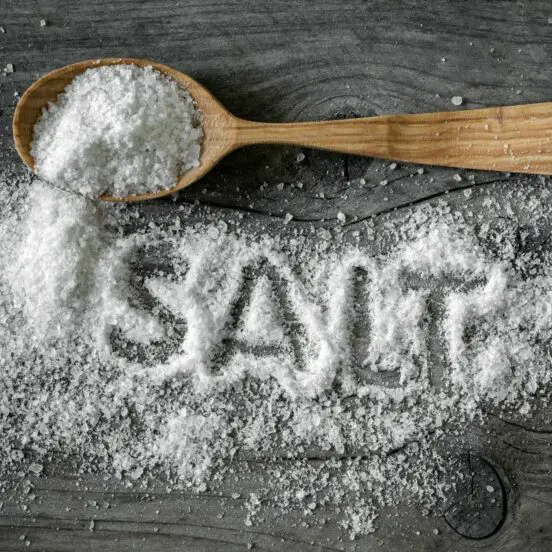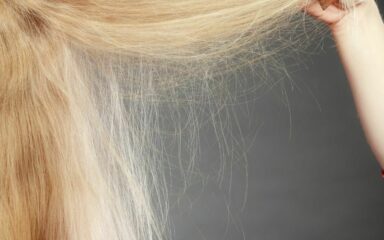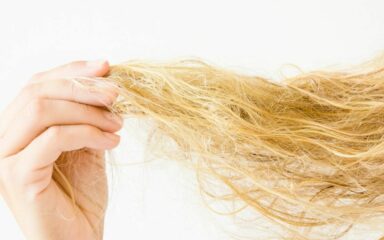Sulfate-free shampoo is usually recommended as a follow-up to a keratin straightening or Brazilian blow dry, but did you know that a sodium chloride free shampoo is equally important? Choosing no salt shampoos will help your hair feel healthier and smoother, reducing free and minimizing the loss of the keratin applied to the surface of your hair.
Why Is Sodium Chloride an Active Ingredient in Many Shampoos?
When you ask people about common ingredients in shampoo formulas, I am pretty sure table salt is not the first thing that comes to mind. And yet, sodium chloride is a widespread ingredient in many shampoos and can significantly reduce the lifetime of your expensive keratin treatment. It has many properties that make it really good for formulating a shampoo: it thickens, prevents the growth of bacteria and other nasties that could make shampoo go off, and acts as a surfactant opening the cuticle of the hair for more effective cleansing. And it's cheap as dirt, so no wonder shampoo manufacturers love it!
Sodium chloride in shampoo is not harmful, provided your hair isn't chemically treated. It won't damage your health, but it can dry your hair and cause frizz, so choosing a sodium chloride-free shampoo can make your hair noticeably easier to manage and softer. But if you have had a keratin treatment, you must go salt-free.
Benefits of Shampoo With No Sodium Chloride
Right out of the box, sodium chloride-free shampoo is much more gentle on your hair and will not strip the protein and moisture that makes hair healthy. The salt-free shampoo is an easy way to reduce damage and frizz long-term for hair that has been through a lot, such as bleaching or chemically treating it. If you had a keratin treatment, sodium chloride in the shampoo will strip it faster and reduce the adequate treatment time.
So if you care about protecting the keratin in your hair and keeping it frizz-free, choosing a shampoo with no sodium chloride is your best choice. Remember that conditioners sometimes also have salt in them, as it's used as a thickener. So keep that in mind when you are buying your hair care products.
How To Find Shampoos Without Sodium Chloride
Sodium chloride, aka salt, is a ubiquitous ingredient in shampoo as it preserves and thickens the shampoo very cheaply. So most cheap shampoos will use them. Your best bet is to pay careful attention to the ingredients list. Still, if you are trying to make a shortlist ahead of doing proper research, the best place to start is sulfate-free shampoos and shampoos marketed for keratin treatment after-care.
However, when looking for shampoos without sodium chloride, don't just assume that anything with sodium means it's not salt-free. The combination of Sodium and Chlorine in salt makes it stripping, but other ingredients are chemical compounds with sodium that aren't surfactants or cleansers.
Sometimes salt is added to products such as volume sprays, hair thickening shampoo, or wave spray. This is because sodium chloride will slightly open the cuticle, roughing the hair and making the individual strands look thicker.
How To Choose the Best Sodium Chloride Free Shampoo?
To choose the best no-salt shampoo, start by assessing the needs of your hair and what you want to achieve in terms of styling. Choosing the right shampoo sets the proper foundation for styling, even hair drying. If your goal is smooth hair with no flyaways, you should select a smoothing shampoo that will weigh hair down. If you want more of a natural wave or curl, choose a shampoo with hydrating ingredients.
The more you wash your hair after a keratin treatment, the quicker the effects of said treatment will wash off, even if you use a salt-free shampoo. But if you need to wash your hair more than a couple of times a week, you can co-wash every other wash instead to avoid stripping your hair. Co-washing is nothing more than using a cleansing conditioner instead of your regular shampoo to eliminate light dirt and sweat without damaging your hair.
Which Shampoo Is Best for Keratin-Treated Hair?
After a keratin treatment, choosing a sulfate-free shampoo is non-negotiable. But you should go further than just solving the question of how to make a keratin treatment last longer and aim for a shampoo that improves the quality of your hair. Choosing a sodium chloride free shampoo with smoothing and anti-frizz properties will increase the straightening effect of the keratin treatment.
Most people who choose a Brazilian blowdry do it because their hair is damaged, be it from bleach, color, or hair styling. Keeping up the moisture levels in your hair is key to improving the condition of your hair and making the most of all those hours spent at the salon. Choose a shampoo that has hydrating and damage restoring properties for best results.
What's Wrong With Silicone?
No conversation about sodium chloride-free shampoos is complete without mentioning silicones. Silicones are used for similar purposes as keratin treatments. They cover the hair in a thin layer of polymers that make the hair shiny and smooth... but unlike keratin treatments, that layer of plastic is not part of your hair.
Unless properly cleansed, silicones will build up on your hair, making your scalp itchy and your hair dull and dry. It's like covering your hair in a permanent layer of plastic that prevents nutrition and moisture from coming in.
As you use more and more silicone-based products, your hair becomes duller and frizzier unless they are correctly removed by washing the hair. However, sulfate-free and sodium chloride-free shampoos are not strong enough to remove all of those silicones. You need sulfate cleansers for that! So if you choose an SLS-free hair care regime (or need one due to keratin treatments), make sure you avoid silicones in your hair care.
Is Sodium Chloride-Free the Same As Sulfate-Free?
No, not all sulfate-free shampoos are sodium chloride-free and the other way around. If you have had a keratin treatment, choosing a sulfate-free shampoo is a must. But selecting a shampoo that is also salt-free will extend the life of your treatment longer, as sodium chloride can strip your hair.
What Is the Difference Between Sulfate and Sulfate-Free?
Sulfates in shampoos and conditioners are variations of Sodium Lauryl Sulfate, used as a surfactant to make the shampoo foam up and to help lift dirt better, which is great if it wasn't that it also raises the keratin treatment, moisture and proteins straight off the surface of your hair. A sulfate-free shampoo is formulated differently and cleans hair more gently. They won't make so much foam and will feel more creamy and less like shampoo.
Sulfate-free shampoo has a bit of a learning curve: you need to let it work its way on your hair and massage it gently, so the mechanical motion lifts the dirt and residue from your scalp. And if you use silicone-based haircare, you will need to use a sulfate shampoo to cleanse that. So if you have had a keratin treatment and want to keep it for as long as possible... avoid silicones in your shampoo, conditioner, and leave-in products.
How To Know If A Shampoo Has Hidden Sulfates
I haven't found a shampoo that advertises the fact that they have sulfates, but most shampoos do. Most grocery store shampoo brands, anti-dandruff, and deep cleansing or clarifying shampoos, in particular, tend to have sulfates. But even shampoos marketed for dry or frizzy hair can use sulfates and salt as both are commonplace and cheap for manufacturers.
If you want to know whether a shampoo has hidden sulfates or not, you'll need to look at the ingredients list. Look for Sodium Lauryl Sulfate or Sodium Laureth Sulfate in the ingredient list and avoid shampoo containing either of those.
Why You Need a Salt and Sulfate-Free Keratin Booster Shampoo
Keratin treatments add keratin to the hair's surface to smooth down frizz and sometimes even change the texture to a straighter style. Natural hair is made of keratin, so basically, this treatment helps refill the hair's natural surface by attaching more proteins to it. This allows the cuticle to become smoother and can help both damaged hair and hair that has been chemically treated or bleached.
When you use a shampoo with sodium chloride or sulfates (another type of surfactant), you remove that extra layer of keratin and damage and dry your hair. So whether you have had a keratin treatment recently and want it to last, or are just concerned about damage to your hair, choosing a sodium chloride free shampoo is a wise move.



